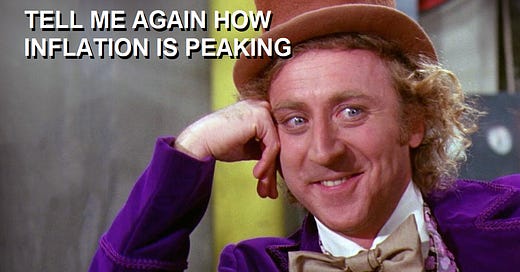After yesterday’s scorching inflation report, today saw the release of the latest PPI data. Today’s data showed an 11.3% increase in the PPI. It came in above the May figure of 10.9% and surpassed the consensus expectation of 10.7%.
A funny thing happened on the way to finding this data. I typically like to look at the ‘final demand: finished goods’ data as its series goes back much further than the ‘final demand’ figure. You might want to sit down for this one, it could well be a shock.
Final demand: finished goods PPI inflation came in at 18.6%. This is the second highest this series has ever been. Only the November 1974 reading at 19.6% was higher.
Final demand figures rose 1.1% month-over-month with goods prices leading the way with a 2.4% increase. The majority of this increase is attributed to higher gasoline prices. This was followed closely by costs for diesel, electricity, natural gas, and vehicles & equipment. Services rose 0.4% month-over-month. The majority of this increase came from higher food costs.
Now all eyes are on the Fed’s FOMC meeting July 26th & 27th. While the Fed’s top leaker has said a 1% rise in the Fed Funds rate is off the table, I beg to differ. I think it is a distinct possibility. I also believe the market is pricing it in. The next inflation data release, the PCE, isn’t going to be released until July 29th. This means the FOMC meeting will be reflecting upon the most recent CPI and PPI releases to guide their decision concerning inflation. As long as the employment situation stays tight (3.6% unemployment) the Fed’s dual mandate will force them into seeing inflation as their primary enemy.
While a 1% FFR rate hike might be seen by many as “aggressive”, it will not be aggressive enough. The Fed’s feeble attempts at controlling inflation has, thus far, proven to be weak and ineffective. They are well behind the curve here and they know it. Their tightening, however, is causing chaos in markets across the world. Emerging markets are seeing considerable stress. This is primarily due to borrowing USD and paying debts back in local currencies. As the dollar strengthens, debts become increasingly difficult to repay. We are also seeing a massive liquidity hole forming in Europe.
The eurodollar futures curve has been getting slammed. This is going to manifest as a full blown liquidity crisis. Debts that can’t be paid back, won’t be. This will lead to some serious deflation.
My primary worry is a repeat of the Fed’s mistakes in the 70s. Once the recession hits, the Fed is going to want to pivot on their tightening policy. By cutting interest rates and restarting QE, inflation will again spiral out of control. They will be tempted to use highly manipulated “core” inflation components to announce mission accomplished and try to revive the debt-based economy. They won’t notice that they will be jumping out of the pot and right into the fire.








EURL (3x Europe FTSE Bull) has been crushed over the past year, falling from $40 to $14. But that's a drop in the bucket compared to what will happen if there's a debt crisis in Europe.